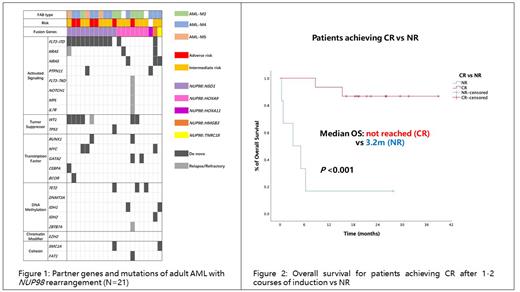Introduction: Nucleoporin 98 ( NUP98) rearrangement has been proposed in 2022 as one type of acute myeloid leukemia (AML) with defining genetic abnormalities. It occurred more often in pediatric leukemia with poor outcome. However, in adult AML with NUP98 rearrangement, patients may show different clinical characteristics, genetic profile and outcome, as we reported here.
Method: We retrospectively collected and analyzed the data of adult AML patients with NUP98 rearrangement who were diagnosed at Shanghai Institute of Hematology from May 2019 to December 2022, including clinical characteristics, laboratory examination, genetic abnormalities, treatment strategies and outcome. All patients underwent next generation sequencing and RNA sequencing.
Result: A total of 21 AML patients with NUP98 rearrangement were included in this study, counting for 2.3% of all AML patients (930 cases). The median age was 40 (19-64) years old. The median white blood cell and platelet count was 31.1 (1.5-313.6) and 48 (15-140) ×10 9/L, respectively. Interestingly, 11 (52.4%) patients suffered from severe or fatal hemorrhage irrelative with platelet count or coagulative function, including 4 cerebral bleeding (3 died), 1 urgent uterine bleeding, 1 gastro-intestinal bleeding, 1 retina bleeding and 4 massive bleeding of subcutaneous soft tissue or mucous membranes.
The FAB types involved M2, M4 and M5. Eight patients carried normal karyotype, 6 were found with t(7;11)(p15;p15), all of whom had NUP98::HOXA9 fusion gene, 2 with +8 and 1 complex karyotype. According to ELN 2022 risk classification, 14 (66.7%) were at intermediate risk and 6 (28.6%) at adverse risk, 1 unclassified. Five fusion partners with NUP98 were detected: NUP98::NSD1 (11 cases), NUP98::HOXA9 (7 cases), NUP98::HOXA11, NUP98::HMGB3 and NUP98::TNRC18 (each with 1 case). Of which NUP98::TNRC18 was first reported by our center (see Cheng WY, et al. Proc Natl Acad Sci U S A. 2022;119(49):e2211429119). NUP98 rearrangement also co-existed with several mutations. FLT3-ITD (12 cases, of which 10 were co-existed with NUP98::NSD1) and WT1 (7 cases) were most frequently occurred. Patients with relapse/refractory disease had more additional mutations than de novo status (Figure 1).
Nineteen patients were treated with standard dose of “7+3” induction therapy, and 2 with hypomethylating agents (HMA) plus venetoclax (VEN). Complete remission (CR) was achieved by 8 (38.1%) patients after first induction, 2 (9.5%) early deaths were both due to cerebral hemorrhage. Salvage induction varied from intensive chemotherapy (IC, including “7+3” and CLAG±M) to low-intensity therapy (LIT, including priming chemotherapy±HMA and HMA+VEN). FLT3 inhibitors (FLT3i) were added to 5 patients carrying FLT3-ITD, and they all achieved CR. A total of 15 (71.4%) patients achieved CR after 1-2 courses of induction (8 mainly benefited from IC, 7 mainly benefited from LIT±FLT3i), 1 survived from allogeneic hematopoietic stem cell transplantation (allo-HSCT) without reaching remission before, and 3 died from refractory disease within 6 months. Three patients relapsed after CR, 2 died without allo-HSCT, and the other one survived after CR2 and sequential allo-HSCT. A total of 14 patients underwent allo-HSCT after CR, 7 were measurable residual disease (MRD) negative and 7 were positive by flow cytometry before HSCT, none of them relapsed till the last follow-up. With a median follow-up time of 19.2 months, the median overall survival (OS) and event-free survival (EFS) were not reached, estimated 2-year OS and EFS rate were 66.7% and 57.1%, respectively. For patients achieving CR or not, the median OS were not reached vs 3.2 months (95% CI 0-8.361, P<0.001, Figure 2). Ten patients were diagnosed with NUP98::NSD1 co-occurring with FLT3-ITD (once considered as unfavorable prognosis), ending up with a CR rate of 70%, and a 2-year OS and EFS rate of 80% and 60%, respectively, making no significant difference compared to others ( P=0.236 and 0.725, respectively).
Conclusion: Adult AML with NUP98 rearrangement may combine with a set of partner fusion genes and mutations, with NUP98::NSD1 and FLT3-ITD as the most common combination. Both IC an LIT can induce CR, and FLT3i will benefit those with FLT3 mutations, also prevention of fatal bleeding should be paid attention to. After achieving CR with whatever method and whatever MRD status, allo-HSCT is the key to long-term survival.
Disclosures
No relevant conflicts of interest to declare.


